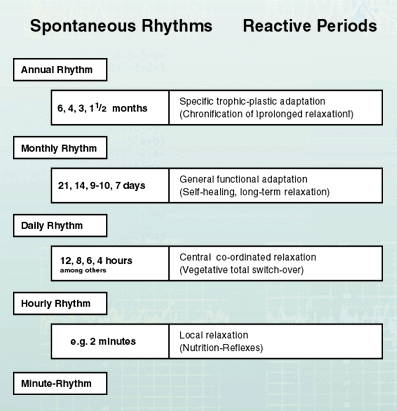The illustrations so far have primarily referred to the so-called spontaneous-rhythmic processes in humans which are therefore constantly taking place. Even when a person is resting or sleeping, they emerge with particular intensity in their regulating principles. Furthermore, the organism also has the ability to form further rhythmic-periodical processes, and that is preferably at the time when it is in demand and under pressure. This means that the reactions of the organism also take place in a rhythmic-periodic structure. These time structures are called reactive periods.
In the spectrum of the wavelengths these reactive periods are each between the spontaneous rhythms (illustration 22). Their size and complexity also increase with the wavelength, and, based on simple relaxation processes, increasingly take on the feature of comprehensive adaptation processes, whereby the body adjusts new functional balances. This also includes the self-healing reactions of the organism.
The periodic duration of the reactive periods admittedly deviates from the spontaneous rhythms, but, as a rule, relate to the neighboring spontaneous rhythms in a simple whole numbered-harmonic way. The reacting organism then has new harmonies ready whereby the overall context of temporal structures can be maintained. The reactive periods are triggered by the interventions putting on strain, and disappear again, when the functional balances have been re-established, the disturbances compensated.

